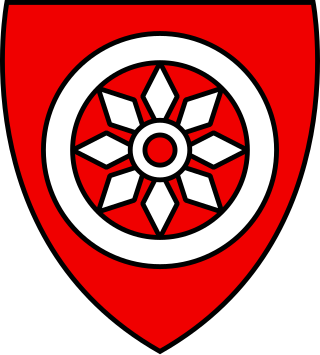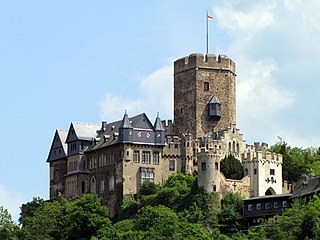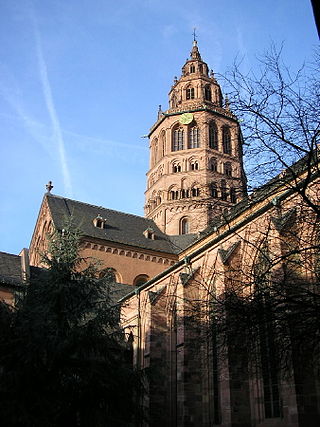External links
- "Siegfried II". Germania Sacra people index (in German). Göttingen Academy of Sciences and Humanities.
Siegfried II | |
|---|---|
| Archbishop of Mainz | |
| Church | Catholic Church |
| Diocese | Electorate of Mainz |
| In office | 1200–1230 |
| Personal details | |
| Died | 9 September 1230 Erfurt |
Siegfried II von Eppstein (died 9 September 1230) was archbishop of Mainz from 1200 to 1230.
Siegfried was born the second son Gerhard I of Eppstein and hit an ecclesiastical career. Already in 1189 he was the owner of the parish of St. Gangolph in Mainz. He was the provost of St. Martin in Worms 1194 and of St. Peter in Mainz 1196.

Adolf was the count of Nassau from about 1276 and the elected king of Germany from 1292 until his deposition by the prince-electors in 1298. He was never crowned by the pope, which would have secured him the imperial title. He was the first physically and mentally healthy ruler of the Holy Roman Empire ever to be deposed without a papal excommunication. Adolf died shortly afterwards in the Battle of Göllheim fighting against his successor Albert of Habsburg.

Mainz Cathedral or St. Martin's Cathedral is located near the historical center and pedestrianized market square of the city of Mainz, Germany. This 1000-year-old Roman Catholic cathedral is the site of the episcopal see of the Bishop of Mainz.

Lahnstein is a verband-free town of Rhein-Lahn-Kreis in Rhineland-Palatinate, Germany. It is situated at the confluence of the Lahn with the Rhine, approximately 6 kilometres (3.7 mi) south of Koblenz. Lahnstein was created in 1969 by the merger of the previously independent towns of Oberlahnstein on the south side of the Lahn and Niederlahnstein on the north side. In 2020, it had a population of 18,030.
Henry II "the Rich" of Nassau was Count of Nassau. He distinguished himself in particular by his chivalrous and devout spirit. He was charitable and made great donations to the church, so that the monasteries and prayer houses in the area of present-day Nassau experienced the most significant bloom in his time. The greatest favour was the Teutonic Order to enjoy, to which he donated especially for the renunciation of his brother's, upon his entry into the order. Henry participated in the Sixth Crusade. He was the builder of the castles Sonnenberg, Ginsburg and Dillenburg.

The Elector of Mainz was one of the seven Prince-electors of the Holy Roman Empire. As both the Archbishop of Mainz and the ruling prince of the Electorate of Mainz, the Elector of Mainz held a powerful position during the Middle Ages. The Archbishop-Elector was president of the electoral college, archchancellor of the empire, and the Primate of Germany as the papal legate north of the Alps, until the dissolution of the empire in 1806.
Bohemond of Warnesberg was the Archbishop of Trier and a Prince Elector of the Holy Roman Empire from 1286 to his death.
The Lords of Eppstein were a family of German nobility in the Middle Ages. From the 12th century they ruled extensive territories in the Rhine Main area from their castle in Eppstein, northwest of Frankfurt, Germany.

Peter of Aspelt was Archbishop of Mainz from 1306 to 1320, and an influential political figure of the period. He brought the archbishopric to its peak of power.

Siegfried III von Eppstein was Archbishop of Mainz from 1230 to 1249. He in 1244 granted freedom to the citizens of Mainz, who subsequently could run their affairs more independently though their own council; in law it remained an episcopal city.

Sonnenberg is a borough of Wiesbaden, the capital of the state of Hesse, Germany. Formerly an independent municipality, Sonnenberg was incorporated into Wiesbaden on 28 October 1926. The borough has approximately 8,000 residents.
Siegfried is a German-language male given name, composed from the Germanic elements sig "victory" and frithu "protection, peace". The German name has the Old Norse cognate Sigfriðr, Sigfrøðr, which gives rise to Swedish Sigfrid, Danish/Norwegian Sigfred. In Norway, Sigfrid is given as a feminine name.
Rupert IV of Nassau, German: Ruprecht IV. von Nassau, was Count of Nassau. He later became a Knight of the Teutonic Order.

Lahneck Castle is a medieval fortress located in the city of Lahnstein in Rhineland-Palatinate, Germany, south of Koblenz. The 13th-century castle stands on a steep rock salient above the confluence of the Lahn River with the Rhine, opposite Stolzenfels Castle, in the district of Oberlahnstein. Its symmetrical plan, an oblong rectangle, is typical of the later castles of the time of the Hohenstaufen. The pentagonal shape of the bergfried is rare for castle towers.
Siegfried II may refer to:
Christian II (c.1185 – 21 November 1253), also called Christian von Weisenau and Christian von Bolanden, was the archbishop of Mainz from 1249 to 1251. He belonged a respected local family of Weißenau, descended from the ministeriales of Bolanden and related to the lords of Eppstein. His parents' names are unknown, but his grandparents were Dudo and Gisela and his brothers were Dudo and Embricho.

The imperial election of 1273 was an imperial election held to select the emperor of the Holy Roman Empire. It took place in Frankfurt on October 1.
The imperial election of 1292 was an imperial election held to select the emperor of the Holy Roman Empire. It took place in Frankfurt on May 5. Emperor Rudolf I of Germany had died on 15 July 1291.

The Free City of Mainz was a city-state that existed from 13 BC to 1803 in the early Middle Ages, which played a crucial role in the Christianization of the German and Slavic communities during the Middle Ages.

Rauenthal is a town in the Rheingau, in the Rheingau-Taunus-Kreis, Hesse, Germany. It became part of Eltville in 1977, then officially name Rauenthal (Rheingau). It is known for growing wine.